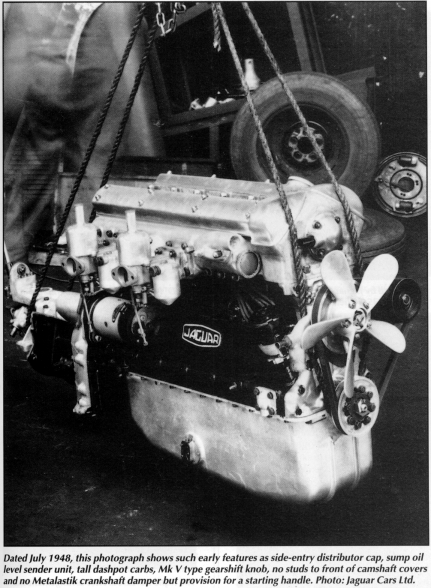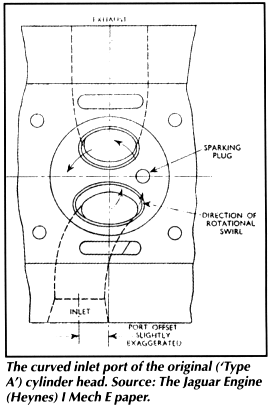|
|
 |
[ Main ] [ 1 ] [ 2 ] [ 3 ] [ 4 ] [ 5 ] [ 6 ] |
|
The XK Jaguar engine, created by some of the best engineers in the business
at the time, certainly ranks amongst the classic engine designs of all
time. Always a heavy engine, it nevertheless was able to achieve remarkable
competition successes in the 1950s and as a volume production engine it was
pretty much in a class of its own for the next decade or so until other
manufacturers began to catch up. Of course all good things have to come to
an end and the end of the XK is, sadly, like that of too many human sports
personalities. It soldiered on until it was way past its best, its
greatness perhaps tarnished by its final years.

If it starts out good, how do you make it better?The definitive XK has to be the original 3.4 litre of 83 mm bore and 106 mm stroke (fig 1). This is the size it was intended to be and all other variants were compromised in some way from this, the original design. (Actually, to be pedantic, at a late stage to gain some extra torque the stroke was lengthened from the proposed figure of 98 mm, which would have given 3.2 litres. 40 years or so later a Jaguar 3.2 litre did appear - itself an offspring of the XKs successor, the AJ6.) A four cylinder variant also reached a late stage of development but, in a manner repeated later by the eight cylinder version of the V12, was rejected for lack of refinement and never entered production.
The most innovative feature of the XK for a volume produced engine was its twin overhead camshaft layout at a time when side valve engines were still commonplace (fig 2). Overhead camshaft drives had a reputation for being noisy but careful development ensured that the XK was quite acceptable in this respect and the twin chain drive lasted with only minor, though numerous, alterations right through to the end. Close attention had been given to proper lubrication of the camshafts and chains and this contributed to the lack of problems in this respect all through the XKs life. Some have questioned the manual adjustment of the top chain but the worst that can truly be said of it is that it was a minor inconvenience. Quite early on the original spring blade tensioner for the bottom timing chain (fig 3) was replaced by a Reynold hydraulic tensioner which itself changed in detail over the years as did the chain guides. 5/16" lift cams were initially used because of a fear that clumsy mechanics used to simpler engines would bend valves during repairs. This caution proved to be unnecessary and the intended 3/8" lift cams were introduced, first as an upgrade option then as standard. Another early change was from a gear oil pump to the Hobourn Eaton rotor type.
I hesitate to mention the dreadful sludge traps in the XK crankshaft - probably its worst feature. Any minute debris which could get that far into the engine could not possibly be harmful yet by collecting it together a potential problem was created for the later life of the engine. |
| [ Main ] [ 1 ] [ 2 ] [ 3 ] [ 4 ] [ 5 ] [ 6 ] |
Email aj6engineering@ntlworld.com, Tel/Fax:- 0044 (0)1625 573556 |
 A feature of any really good product is the difficulty of making it better.
In the case of the XK this certainly applies and of the changes it
underwent during its production life relatively few stand out as being
worthwhile improvements on the original. As an indicator of how rare this
situation is, consider another legendary engine - the Rolls Royce Merlin
aero engine - which made the Spitfire, Hurricane, Mustang, Mosquito and
Lancaster so outstanding during the war years in which the XK was
conceived. In its original form the Merlin was plagued with problems and
needed an enormous amount of development to become a world beater. The XK
was pretty good right from the start.
A feature of any really good product is the difficulty of making it better.
In the case of the XK this certainly applies and of the changes it
underwent during its production life relatively few stand out as being
worthwhile improvements on the original. As an indicator of how rare this
situation is, consider another legendary engine - the Rolls Royce Merlin
aero engine - which made the Spitfire, Hurricane, Mustang, Mosquito and
Lancaster so outstanding during the war years in which the XK was
conceived. In its original form the Merlin was plagued with problems and
needed an enormous amount of development to become a world beater. The XK
was pretty good right from the start.
 Some other changes were clearly improvements - for instance the much
revised long stud block gave a more direct load path between head and main
bearings, provided more secure clamping pressure on the head gasket and
eliminated the bore distortion which had become apparent from stretching
the block to 4.2 litres. (This lesson was not forgotten when the AJ6 block
was designed - the head clamping stresses being taken down via heavy
ribbing in the outer wall of the structure). Mechanical noise was reduced
by the introduction in 1969 of modern parabolic cam profiles applying less
severe accelerations to the valve gear than the simple three arc cams used
previously.
Some other changes were clearly improvements - for instance the much
revised long stud block gave a more direct load path between head and main
bearings, provided more secure clamping pressure on the head gasket and
eliminated the bore distortion which had become apparent from stretching
the block to 4.2 litres. (This lesson was not forgotten when the AJ6 block
was designed - the head clamping stresses being taken down via heavy
ribbing in the outer wall of the structure). Mechanical noise was reduced
by the introduction in 1969 of modern parabolic cam profiles applying less
severe accelerations to the valve gear than the simple three arc cams used
previously.